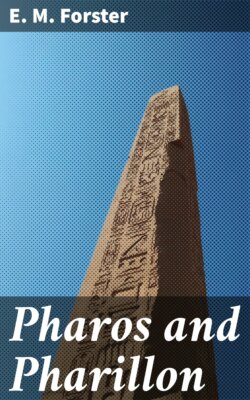Читать книгу Pharos and Pharillon - E. M. Forster - Страница 7
На сайте Литреса книга снята с продажи.
III
ОглавлениеTable of Contents
“I have taken a city,” wrote the Arab conqueror of Alexandria, “of which I can only say that it contains 4000 palaces, 4000 baths, 400 theatres, 12,000 greengrocers, and 40,000 Jews.” It contained a lighthouse, too, for the Pharos was still perfect and functioned for a few years more, lighting the retreating fleets of Europe with its beams. Then a slow dissolution began, and it shrinks, looms through the mists of legend, disappears. The first, and the irreparable, disaster was the fall of the lantern in the eighth century, carrying with it scientific apparatus that could not be replaced. Annoyed (say the Arabs) with the magic mirror that detected or scorched their ships, the Christians made a plot, and sent a messenger to Islam with news of a treasure in Syria. The treasure was found, whereupon the messenger reported something supreme—the whole wealth of Alexander and other Pharaohs which lay in the foundations of the lighthouse. Demolition began, and before the Alexandrians, who knew better, could intervene, the mirror had fallen and was smashed on the rocks beneath. Henceforward the Pharos is only a stump with a bonfire on the top. The Arabs made some restorations, but they were unsubstantial additions to the octagon, which the wind could blow away. Structural repairs were neglected, and in the twelfth century the second disaster occurred—the fall of the octagon through an earthquake. The square bottom story survived as a watch-tower. Two hundred years later it vanished in a final earthquake, and the very island where it had stood modified its shape and became a peninsula, joined to the mainland by a strip of sand.
Though unable to maintain the lighthouse on earth, the Arabs did much for it in the realms of fancy, increasing its height to seven hundred feet, and endowing it with various magical objects, of which the most remarkable was a glass crab. There really were crabs at Alexandria, but of copper, quite small, and standing under Cleopatra’s Needle; America possesses one to-day. Oriental imagination mixed two monuments into one, and caused a Moorish army to invade the Pharos and to ride through its three hundred rooms. The entrance gate vanished, and they could not find their way out, but ever descending the spirals came at last to the glass crab, slipped through a crack in its back and were drowned. Happier, though equally obscure, was the fate of another visitor, the poet El Deraoui. Who sings:
A lofty platform guides the voyager by night, guides him with its light when the darkness of evening falls.
Thither have I borne a garment of perfect pleasure among my friends, a garment adorned with the memory of beloved companions.
On its height a dome enshadowed me, and there I saw my friends like stars.
I thought that the sea below me was a cloud, and that I had set up my tent in the midst of the heavens.
Only occasionally does the note of disillusionment and bitterness creep in. Jelaled Din ibn Mokram complains that:
The visitor to Alexandria receives nothing in the way of hospitality except some water and a description of Pompey’s Pillar.
Those who make a special effort sometimes give him a little fresh air too, and tell him where the Pharos is, adding a sketch of the sea and its waves and an account of the large Greek ships.
The visitor need not aspire to receive any bread, for to an application of this type there is no reply.
As a rule, life in its shadow is an earthly ecstasy that may even touch heaven. Hark to Ibn Dukmak:
According to the law of Moses, if a man make a pilgrimage round Alexandria in the morning, God will make for him a golden crown set with pearls, perfumed with musk and camphor and shining from the east to the west.
Nor were the Arabs content with praising the lighthouse: they even looked at it. “El Manarah,” as they called it, gave the name to, and became the model for, the minaret, and one can still find minarets in Egypt that exactly reproduce the design of Sostratus—the bottom story square, second octagonal, third round.
The Fort of Kait Bey, built in the fifteenth century and itself now a ruin, stands to-day where the Pharos once stood. Its area covers part of the ancient enclosure—the rest is awash with the sea—and in its containing wall are embedded a few granite columns. Inside the area is a mosque, exactly occupying the site of the lighthouse, and built upon its foundations: here, too, are some granite blocks standing with druidical effect at the mosque’s entrance. Nothing else can be attributed to the past, its stones have vanished and its spirit also. Again and again, looking at the mosque, have I tried to multiply its height by five, and thus build up its predecessor. The effort always failed: it did not seem reasonable that so large an edifice should have existed. The dominant memory in the chaos is now British, for here are some large holes, made by Admiral Seymour when he bombarded the Fort in 1882 and laid the basis of our intercourse with modern Egypt.
